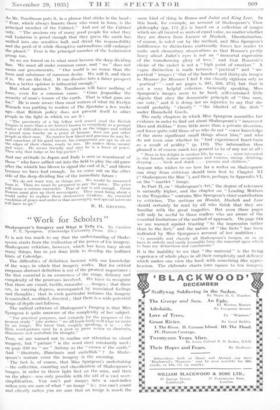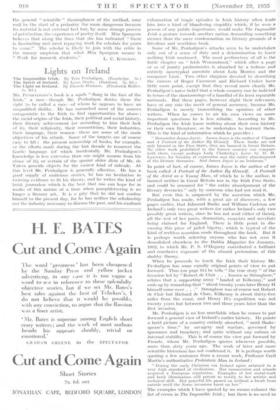" Work for Scholars
Shakespeare's Imagery and What it Tells Us. By Caroline F. E. SpUrgeon. (Cambridge UniVersity Press. 2,5s, ) IT is not too much to say that the understanding of Shake- sl lease starts from the realisation of the power of his imagery. l'i.akespeare criticism, however, which has been busy abut Many things, has as yet done .little to develop the brilliant
hints of Coleridge.
• The difficulties of definition increase with our knowledge the ways in which that imagery works. But for critical Purposes abstract definition is not of the greatest importance ; tile first essential is an awareness of the range, delicacy and complexity of the processes involved.. We have to recognise that there are visual, tactile, muscular images ; that these arc, in varying degrees, accompanied, by associated feelings and thoughts ; that in each particular instance the imagery is controlled, modified, directed ; that there is a wide potential
range of depth and fullness.
The radical criticism of Shakespeare's Imagery is that Miss
PuTcon is quite unaware of the complexity of her subject.
. " For practical purposes, and certainly for the purposes of the present study " (she writes) " Wo all know fairly well what we mean by'animage. We. know that, roughly speaking, it is . . . the little word-picture' used by a poet or prose writer to illustrate, illuminate and embellish• his thought."
True, we' are warned not to confine our attention to visual imagery, but " picture " is the word most constantly used : On page 350 we " see " Antony as the " crown o' the earth." And " illustrate, illuminate and embellish " ? In Shake- speare's mature verse the imagery is the meaning. • •
The' fact is, of course, that Miss Spurgeon's undertaking —the collection', counting and classification of Shakespeare's images, in order to throw light first on the man, and then on the plays—was only possible with the aid of a vast over- simplification. You can't put images into a card-index unless you are sure of what " an image " is ; you can't count and classify unless you are sure that an image is much the
same kind of thing in Romeo and Juliet and King Lear. in this book, for example, an account of Shakespeare's Time philosophy (pp. 172 ff.) is based on a collection of imageS which are all treated as units of equal value, no matter whether they are drawn from Lucrece or 111aebeth. Discrimination, of course, is ruled out by the method, and Miss Spurgeon's indifference to distinctions continually forces her reader to make such elementary observations as that Romeo's pretty fancy about Juliet's eyes is net an " immortal expression of the transforming glory of love," and that Bassanio's choice of the casket is not a " high point of emotion." A vague distinction is made between " poetical " and " un- poetical " images (" Out of the hundred and thirty-six images in Measure for Measure I feel I can classify eighteen only as poetical' "—and see pages x, 261, 268, 275); but that is not a very helpful criterion. Generally . speaking, Miss
Spurgeon's images seem to be hard, self-contained little objects that obey the democratic principle of " Oise mini, one vote," and it is doing her no injustice to say that she would probably " classify " " the blanket of the . dark " under Household Goods.
The early chapters in which Miss Spurgeon assembles her evidence in order to find out about Shakespeare's'" innermost likes and dislikes " form little more than a private diversion, and leave quite cold those of us who do not " crave knowledge of the more significant small things about him," and who do not even care whether he " had experienced' heart-burn
as a result of acidity " (p. 119). The infOrmation thus gleaned is of course much too general to be of any use at all
" Next to his delight in outdoor life, lie was . . . most interested in the homely indoor occupations and routine, eating, drinking, sleeping . . . birth and death . . parents and children."
Anyone who wishes to see how far a writer on Shakespeare can stray from criticism should turn first to Chapter XI (" Shakespeare the Man "), and then, perhaps, to Appendix VI, on the " martlet " image.
In Part II, on " Shakespeare's Art," the degree of relevance
is naturally higher, and the chapter on " Leading Motives in the Tragedies " contains Miss Spurgeon's chief contribution to criticism. The sections on Hamlet, Macbeth and Lear should certainly be read by all who think that they are familiar with the great tragedies. But even these pages will only be useful to those readers who are aware of the
essential limitations of the method of approach. .0n page 344 we are warned against trusting " to the impression rather than to the fact," and the nature of " the facts " has been indicated by Miss Spurgeon's account of her ambition " to assemble and classify all Shakespeare's images, so as to have in orderly and easily accessible form the material upon which to base my deductions and conclusions."
It is the inability to see that " the material " is the living experknse of whole plays in all their complexity and delicacy which makes one view the book with something like. appre- hension. The elaborate charts (one square to ten: images), the general " scientific " thoroughness of the method, may well be the start of a pedantry the more dangerous because its material is not external fact but, by some strange process of petrifaction, the experience of poetry itself. Miss Spurgeon believes that along the lines that she has indicated " there is fascinating and most repaying work • for scholars for years to come." The scholar is likely to join with the critic in the uneasy suspicion that what Miss Spurgeon means is













































 Previous page
Previous page